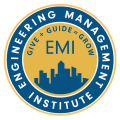In this episode, we talk with Ben Moerman, P.Eng., M.Eng., Ph.D., and project structural engineer at StructureCraft, about earthquake-resistant designs and sustainable construction with mass timber. He shares insights on how mass timber can enhance safety during earthquakes and the challenges it poses compared to steel and concrete. We also explore new technologies for earthquake-resistant structures and sustainable building practices.
***The video version of this episode can be viewed here.***
Engineering Quotes:
Here Are Some of the Questions We Ask Ben:
- How did you transition from studying general engineering to specializing in a unique field like advanced earthquake engineering at a higher level?
- What kind of research did you do at the University of Canterbury, especially given the relevance of seismic lessons from Christchurch to earthquake-prone regions like Southern California?
- Are the experimental research findings from your time at the University of Canterbury now being used in new buildings, and how did they transition from academia to practical application?
- In New Zealand, do they favor performance-based design or integrate research directly into building codes when designing new structures with materials like mass timber?
- Why is mass timber considered beneficial for earthquake-resistant designs?
- How do you apply earthquake engineering principles in your daily work?
- What are the pros and cons of mass timber versus concrete and steel?
- Have you worked on any recent projects where your expertise in earthquake engineering significantly influenced the design or construction process?
- What software or technology has most benefited your work, especially considering the need for advancements compared to the concrete and steel industries?
- How do you believe your work with mass timber contributes to sustainability goals in our industry?
- How do engineers incorporate the research and development outputs from design firms into their projects?
- How long does the vibration testing process typically take, and is it done reactively for immediate issues or proactively for future projects?
- How are seismic research and resiliency strategies for mass timber being adopted globally, and which regions would benefit most?
- What advice would you give to engineers interested in specializing in earthquake engineering or those new to the field?
Here Are Some of the Key Points Discussed About Innovative Ways to Incorporate Mass Timber in Earthquake-Resistant Designs:
- Ben pursued a master’s degree in earthquake engineering to specialize in seismic design and mass timber. He chose Oregon State University and the University of Canterbury for their strong programs in these areas, and was particularly drawn to Canterbury’s expertise shaped by significant earthquakes in 2010 and 2011.
- Ben was drawn to Canterbury’s research on post-tension timber systems for low-damage design, which inspired his work to improve cross-laminated timber (CLT) shear wall lateral capacity using stronger connections and a unique coupled wall system with steel links between CLT panels. This project included a major large-scale test to confirm these enhancements.
- Ben’s research findings from the University of Canterbury are being used in new buildings, especially in New Zealand. This transition from academia to practical application involved collaborations with industry partners like ENGCO, which applied the research on high-capacity connections using mixed-angle screw hold downs in seismic regions, directly integrating these innovative techniques into construction projects.
- In New Zealand, when designing new structures with materials like mass timber, they prioritize performance-based design over directly integrating research into building codes. This allows for flexibility and adaptation to incorporate new findings into building projects without immediate changes to codes.
- Using mass timber in earthquake-resilient structures reduces seismic forces by cutting down on mass compared to concrete. Mass timber’s high level of prefabrication allows for precise and controlled assembly of critical details, improving construction quality and seismic performance.
- In earthquake-resistant designs, the focus is on capacity design for structural resilience, especially important for timber systems. Controlling drifts below code limits minimizes damage and supports future repairability, often achieved by choosing stiff lateral systems and integrating low-damage technologies.
- In timber-based lateral systems, engineers reinforce connections to prevent failures like tension perpendicular to grain using fully threaded screws. When substituting cross-laminated timber (CLT) for concrete walls, they address CLT’s lower shear stiffness by creatively configuring systems, like using C-shapes or coupling CLT panels with beams, to manage drifts effectively and maintain structural integrity.
- Ben is heavily involved in an exciting project in Vancouver, a groundbreaking 14-story mass timber building, which is a first in an earthquake zone. He’s actively exploring lateral system options like steel braces, CLT shear walls, and post-tensioning to address seismic challenges and steer the project toward success.
- In Ben’s role at StructureCraft, engineers use in-house software called Branch to streamline shop drawings and CAD, a valuable tool in the mass timber industry. While there are advances like modal analyses and Python for experiments, skilled design and attention to detail remain crucial in engineering practice and cannot be fully replaced by technology.
- At StructureCraft, engineers focus on efficiency by exploring timber, steel, and mass timber schemes to reduce material use and environmental impact. They specialize in mass timber construction and offer clients carbon accounting tools to compare building systems based on carbon footprint, supporting informed decision-making aligned with sustainability goals.
- StructureCraft conducts innovative research and testing to advance construction materials and connections. Their strong capabilities in destructive and floor vibration testing inform future designs, showcasing a commitment to continuous improvement and innovation.
- The vibration testing process typically varies in duration based on the specific needs. Some tests are conducted reactively for immediate issues, such as strengthening floors for higher live loads requested by tenants, while others are done proactively to inform future projects and ensure compliance with acceleration targets.
- Mass timber systems are highly prefabricated and can be shipped globally, with successful projects completed in places like China. The Pacific Northwest of North America is leading in implementing new mass timber technologies, driven by early adoption, seismic considerations, and expertise among regional engineers.
- For aspiring earthquake engineers, hands-on experimental testing of structural components and systems is key to gaining valuable insights. This practical experience offers a real understanding of structural behavior, particularly important for innovative systems like mass timber in high seismic zones.
More Details in This Episode…
About the Guest: Ben Moerman, P.Eng., M.Eng., Ph.D.

About the Hosts
Mathew Picardal, P.E., SE

Rachel Holland, P.E.

Sources/References:
StructureCraft
University of Canterbury
University of British Columbia
Oregon State University
ENG.CO Group
Johns Hopkins University
Princeton University
T3 with Heinz
World Conference of Timber Engineering 2025
Connect with Ben Moerman, P.Eng., M.Eng., Ph.D., on LinkedIn
This Episode Is Brought to You by PPI

Please leave your comments or questions in the section below on the thing you do to incorporate mass timber in earthquake-resistant designs.








